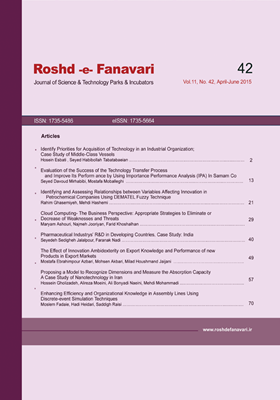-
-
List of Articles
-
Open Access Article
1 - Cloud Computing- The Business Perspective: Appropriate Strategies to Eliminate or Decrease of Weaknesses and Threats
Maryam Ashoori Farid Khosh Alhan najme jooriyan -
Open Access Article
2 - Pharmaceutical Industry’s R&D in Developing Countries Case Study: India
Seyede Sedighe Jalalpour Faranak Nadi -
Open Access Article
3 - Identifying and Assessing Relationships between Variables Affecting Innovation in Petrochemical Companies Using DEMATEL Fuzzy Technique
Rahim Ghasemiye Mehdi Hashemi -
Open Access Article
4 - Enhancing Efficiency and Organizational Knowledge in Assembly Lines Using Discrete-event Simulation Techniques
Moslem Fadaei Hadi Heydari Ghare Bagh Sedigh Reisi -
Open Access Article
5 - Evaluation of the Success of the Technology Transfer Process and Improve Its Perform ance by Using Importance Performance Analysis (IPA) In Samam Co
Seyed Davood MirHabibi Mostafa Mablaghi -
Open Access Article
6 - Proposing a Model to Recognize Dimensions and Measure the Absorption Capacity A Case Study of Nanotechnology in Iran
Hosein Gholizadeh Alireza Moeini Ali Bonyadi Naeini Mehdi Mohammadi -
Open Access Article
7 - The Effect of Innovation Ambidexterity on Export Knowledge and Performance of new Products in Export Markets
Mostafa Ebrahim pour Azbary Milad Hoshmand Chayjani Mohsen Akbari -
Open Access Article
8 - Identifying Priorities for Acquisition of Technology in an Industrial Organization Case Study of Middle-Class Vessels
Hosein Esbati Seyed Habibollah Tabatabaeiyan
-
The rights to this website are owned by the Raimag Press Management System.
Copyright © 2017-2026







